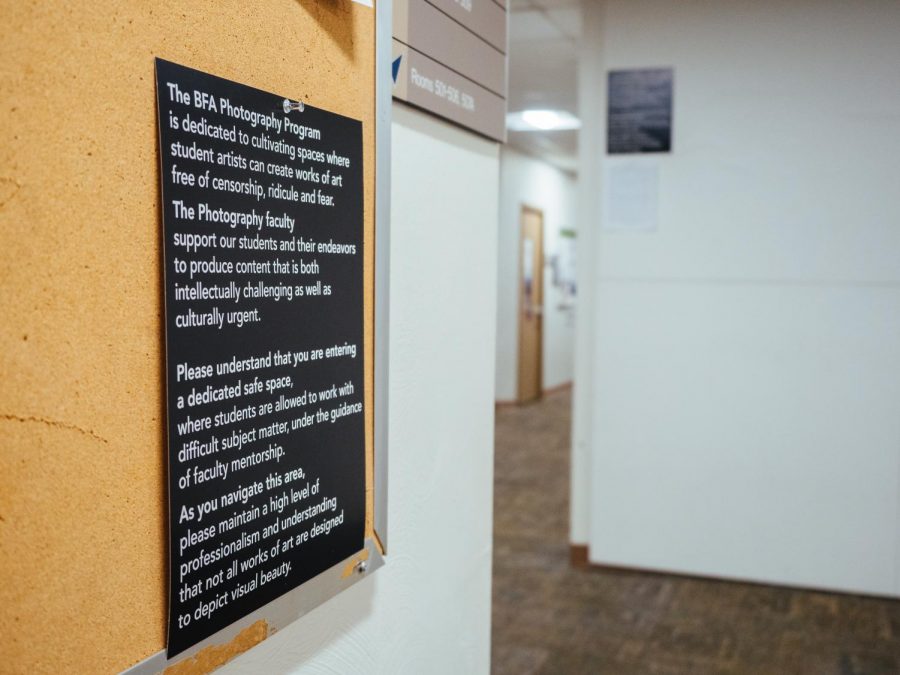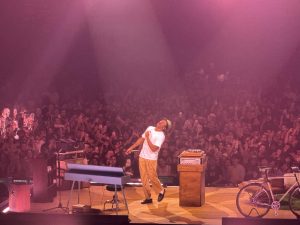Inadequate facilities generate photography department unrest
Photo by Jared Murphy
January 29, 2020
The photography department, currently housed within the School of Communications, has been in a state of unrest due to inadequate facilities, according to the head of the department, April Friges.
The department currently has its facilities on the fifth floor of Academic Hall, where there are several photography labs and the walls hold cloth-covered panels and push pins for students to display and critique their work. When Camryn Drabenstadt, a junior B.F.A. photography major, hung up her project in the hallway, she said that she wasn’t expecting that there would be any issues.
However, her photos, collages that contain pornographic scenes and nudity, were the catalyst that eventually led to Public Safety’s involvement.
Chief Jeffrey Besong stated that Public Safety was called to the fifth floor of Academic Hall on Nov. 9, 2019 at 1:17 p.m. He stated that officers responded to a “loud argument” that pertained to “some materials hanging on the wall that was offending some students.” But Drabenstadt, who was not present for the altercation but was aware of its occurrence, claims that it was professors who have offices on the fifth floor of Academic Hall who were offended.
“It was the three people that have offices on this floor,” Drabenstadt said. “It was three of them, two guys and a lady. And I guess that April [Friges] heard them yelling, and she went over and got really defensive. And I guess they felt threatened, so they called Public Safety.”
Friges confirmed that it was professors who were offended by the work. However, Friges also believes that this incident could have been avoided if photography students had access to a space more suitable than a hallway to display their work. Friges stated that during her time at the university, which has been six years, she has been advocating for better facilities for the department, even making her own suggestions.
“I’ve gone face to face with every administrator under the moon,” Friges said.
Friges also said that in 2016, she conducted a “five-year program review,” with suggestions for the future based on the department’s needs. Friges stated that so far, it doesn’t seem as though her suggestions have been taken into consideration.
Lisa Stefanko, the Vice President of Human Resources, stated that the occurrence with Drabenstadt’s art falls under Title VII, which states that harassment is unlawful when “the conduct is severe or pervasive enough to create a work environment that a reasonable person would consider intimidating, hostile, or abusive.”
Stefanko also stated that because the critique space is in a hallway, which is public, minors may also be present, which could be unlawful. She stated that photography critiques were moved into a “private space.”
Friges stated that an office on the second floor of Academic Hall was proposed as a space for Drabenstadt to display her work. Both Friges and Stefanko agreed that this space was not optimal for long-term use.
However, Stefanko stated that a long-term space for students to display and critique their work was in the process of being finalized. She stated that construction would occur over the summer.
This development occurred following Friges’ interview with The Globe, though according to Drabenstadt, she has since been notified.
This information was confirmed by university spokesman, Lou Corsaro.
However, what happened with Drabenstadt’s work raised the question within the department and the university of what can be considered art.
“Our program is about exploring tough subjects,” Friges said. “That’s what’s art.”
Friges compared Drabenstadt’s work to that of Mickalene Thomas, an artist whose work has been featured in the Museum of Modern Art.
“My project is about the implications that pornographic material has on sex culture,” Drabenstadt said. “And so I was kind of examining a range of decades, like some of it starts in the 40s and 50s and goes up until now, and specifically how men treat their female partners. Like how the line is blurred between what is performed sex and what is actual sex. So I did use pornographic material in my collages, as one would in a project about porn.”
“Camryn was told that her work is not art,” Friges said. “And I am not a hall monitor. It’s not in my job description.”
Friges also said that Drabenstadt’s work had been selected by Hannah Turpin, the Curatorial Assistant of Photography and Contemporary Art at the Carnegie Museum of Art, to be in a juried show.
“The university doesn’t have a policy that says you can only create one type of art or expression,” Stefanko said.
In response to what happened with Drabenstadt’s work, Friges stated that specific signs had to be hung on the fifth floor of Academic Hall.
“Please understand that you are entering a dedicated safe space, where students are allowed to work with difficult subject matter, under the guidance of faculty mentorship,” the signs read. “As you navigate this area, please maintain a high level of professionalism and understanding that not all works of art are designed to depict visual beauty.”
Friges believes that Drabenstadt should continue to create whatever she desires.
“She [Drabenstadt] shouldn’t be fearful,” Friges said. “I can’t tell her not to put her art in the hallway.”


















